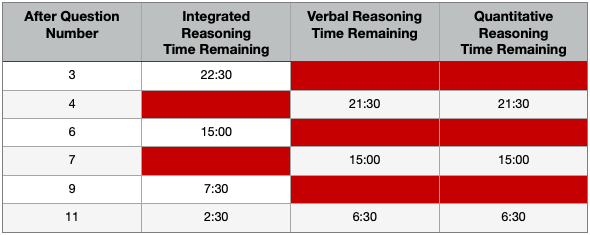Ideal Pacing Strategy for the Executive Assessment
Jun 16, 2022
Effective time management is a crucial component of success on the Executive Assessment (EA). Given unlimited time, a lot of students can solve even the most challenging EA math and verbal questions. But what happens when the clock is ticking and you feel pressure to perform under the time constraints of test day? It's important that you handle this part of the exam well, and the approach we lay out in this article will teach you how.
EA Timing: A Better Way
The biggest mistake a lot of students make when it comes to pacing the Executive Assessment is that they think about timing on a per-question basis. On the Integrated Reasoning section, you have 30 minutes to complete 12 questions, equating to 2:30 per question. On the Verbal Reasoning and Quantitative Reasoning sections, you have 30 minutes to complete 14 questions, or approximately 2:08 per question.
But it's not quite that simple. Some questions take longer to complete than others. Reading Comprehension often takes longer than Sentence Correction, for example. But even within Sentence Correction, some sentences are simply harder — and therefore take longer — than others.
And even if you average it out and assume roughly two minutes per question on the Quant and Verbal sections, that still may not sound like a lot of time to you — especially if you’re not particularly strong on a particular question type. I hear it from my students all the time: Wait, you want me to solve this question in under two minutes!?
The problem with this way of thinking is that when you don't think you have enough time, you rush. And when you rush, you make mistakes. And when you make mistakes… well, it’s hard to get the EA score that will get you into your target business program.
Fortunately, there’s a better way.
Indeed, the solution is simple: Rather than worrying about how much time you’re spending on each individual question, think about it in terms of blocks of questions.
Here’s how it works.
Let’s use Verbal Reasoning for illustrative purposes. As previously mentioned, you’re given 30 minutes to complete 14 questions. But as you may remember about the EA scoring algorithm, those 14 questions are broken up into two 7-question sub-sections. So a better way to think about it is that you have 15 minutes to complete seven questions. This suggests a clear check-in point for you. Once you complete Question #7, ask yourself: Where am I in relation to the 15:00 mark? If you’re ahead of pace, great! You have a little extra breathing room for the next seven questions. If you’re a little behind pace, don’t freak out. But mentally acknowledge that you’ll need to pick up the pace a bit or perhaps skip one or two of the particularly hard questions to ensure that you have enough time to fully work on the questions you have a good shot at getting right.
See how that works?
Now let's take it one step further. Within each sub-section, choose another check-in point. I recommend checking in after the fourth question. You could do it after the third question, but the reason I like the fourth question is that it gives you more time to work on questions before thinking about the time. And that’s the point. When you start a new section, I don’t want you worrying about time because I don’t want you rushing. I want you 100% focused on the question in front of you. This should take the pressure off and allow you to focus on getting right answers. Then, when you finally do glance at the clock, you can adjust as necessary. By the time you get to test day and have done a fair bit of practice, your internal clock should be pretty well calibrated so you shouldn’t be too far off.
Reference Table for Pacing on the Executive Assessment
At the beginning of each section, the countdown clock starts at 30:00. Given the average time per question, this table summarizes the pacing strategy just described and shows you approximately how much time should be remaining at each of your check-in points for each section of the Executive Assessment:

Put It Into Practice
The other great thing about this EA time management strategy is that it gives you something to replicate in your practice sessions.* When you sit down to do practice problems, don’t set your stopwatch to 2:00 per question. Instead, do blocks of seven question in 15 minutes (or four questions in 8:30). As you’re coming up against the buzzer, practice determining which questions to mark/skip and eliminating eye-catcher wrong answers so that you can make educated guesses on the last question or two before time expires. These are things you’ll need to do on test day, and it’s always best to develop the skill during practice.
* Caveat: When you’re first getting started preparing for the Executive Assessment, don’t worry about timing. Focus on learning the underlying content and strategies. Even if it takes you 10 minutes to solve one question early on, that’s okay. The goal is to learn. You’ll find that once it “clicks” and your brain makes the necessary breakthroughs, you’ll be able to solve similar questions much faster the next time you see them. Only after reviewing all of the content and question types should you worry about timing yourself during practice sessions.
Conclusion
As professional athletes get more experience in live-game situations, they talk about how the game starts to "slow down” for them. That needs to be your goal on the Executive Assessment as well. If your brain is going a mile a minute and you’re convinced that you can’t possible solve questions in “only” two minutes, well, you’ve likely lost before you’ve even begun. But you have more time than you think. Once you realize that, the exam will get much easier for you. This EA pacing strategy is one of the best ways to slow things down so that you can do your best on each and every question. A higher score is sure to follow as a result.
